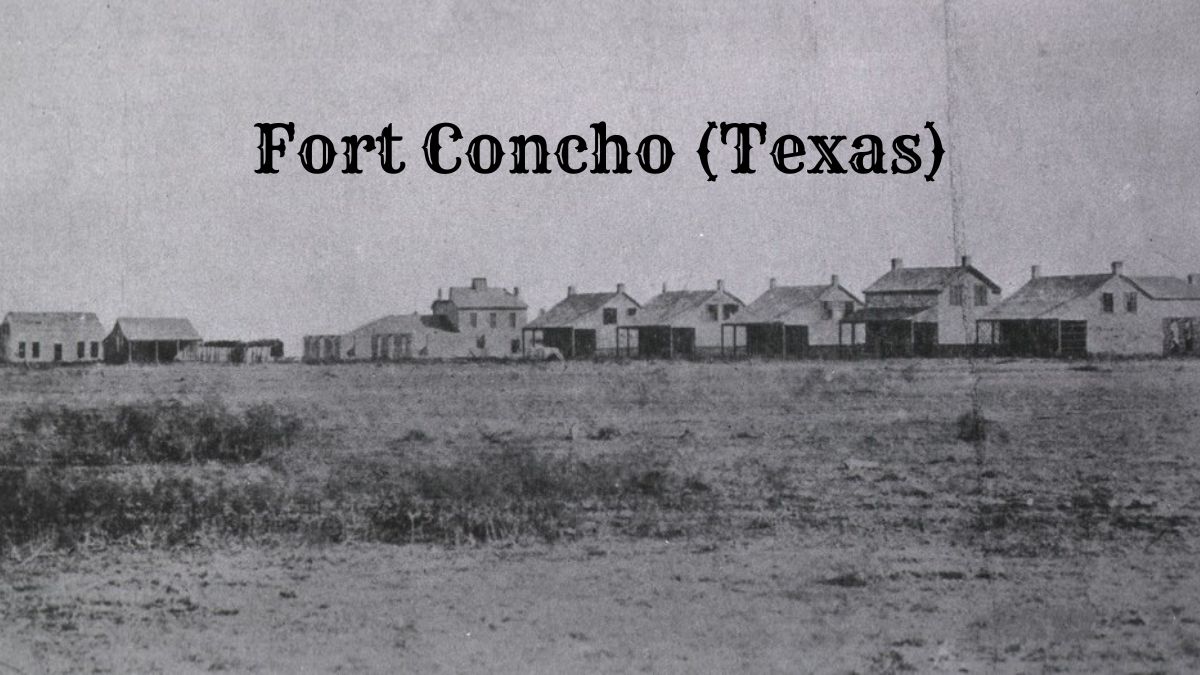Fort Concho, established in 1867 in San Angelo, Texas, offers an insightful glimpse into the frontier military life of the Texas Frontier.
This National Historic Landmark was a crucial outpost during the Indian Wars, protecting settlers and travelers.
The fort’s well-preserved buildings, including barracks, officer quarters, and a hospital, allow visitors to explore soldiers’ daily lives and strategic operations.
Fort Concho is notable for its role as a base for Buffalo Soldiers, particularly the 10th Cavalry Regiment, and its significant involvement in the Indian Wars, making it a vital piece of Texas history.
History of Fort Concho (Texas)
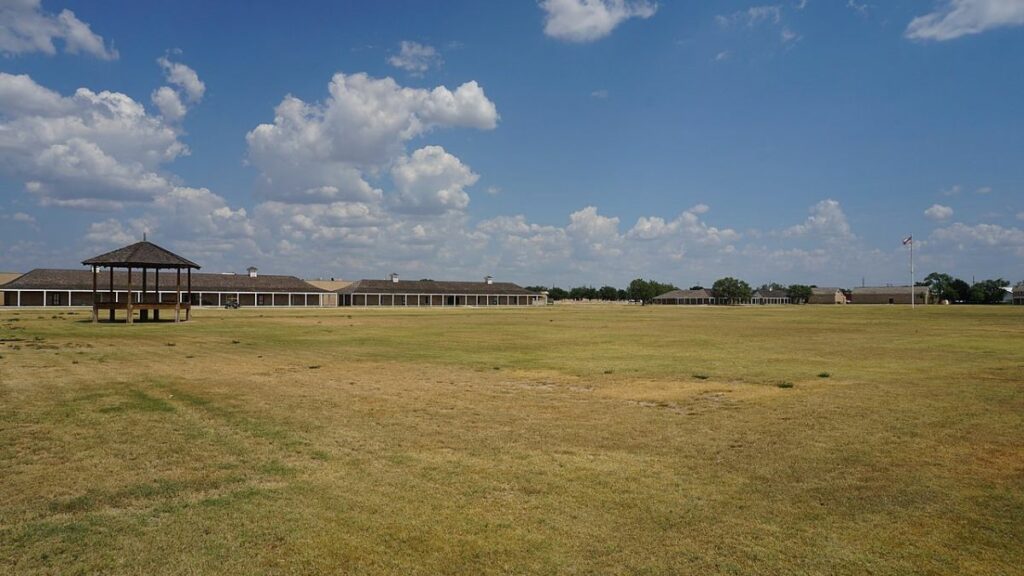
Fort Concho, a designated National Historic Landmark, offers a glimpse into the Texas Frontier life.
Located in San Angelo, Texas, it was established by the United States Army in 1867.
The fort played a vital role in protecting settlers and travelers and in controlling the Native American tribes in the area. It served as a key outpost during the Indian Wars.
Significant Features:
- Year Established: 1867
- Location: San Angelo, Texas
- Original Purpose: Military post to protect frontier settlements
Fort Concho’s structures include barracks, officer quarters, a hospital, and a headquarters building.
Many original buildings have been restored and are open for public tours.
Uses and Activities:
- Historical Tours: Guided and self-guided tours are available.
- Events: Hosts reenactments, educational programs, and special events.
- Museum: Houses various artifacts from the fort’s operational years.
Fort Concho also serves as a venue for various community events and celebrations, making it a living part of San Angelo’s cultural heritage.
Its preserved buildings and rich history attract visitors interested in the military history of the American West.
Today, Fort Concho is a monument to its past, showcasing the challenges and lives of those who served and lived there. It continues to be a vital educational resource and a point of pride for the community.
Pillar of Frontier Defense and Military History
Fort Concho, established in 1867 in San Angelo, Texas, played a crucial role during the Civil War and the Indian Wars and was a significant base for Buffalo Soldiers.
It served as a strategic military post, influencing various historical events and military campaigns in the region.
Civil War and the Establishment
Fort Concho was established shortly after the Civil War to protect frontier settlements from potential threats.
It acted as a safeguard for the expansion into Texas, allowing settlers to establish homesteads. During this period, they marked the strategic placement of military posts to ensure the security of burgeoning communities.
Buffalo Soldiers and the Black Cavalry
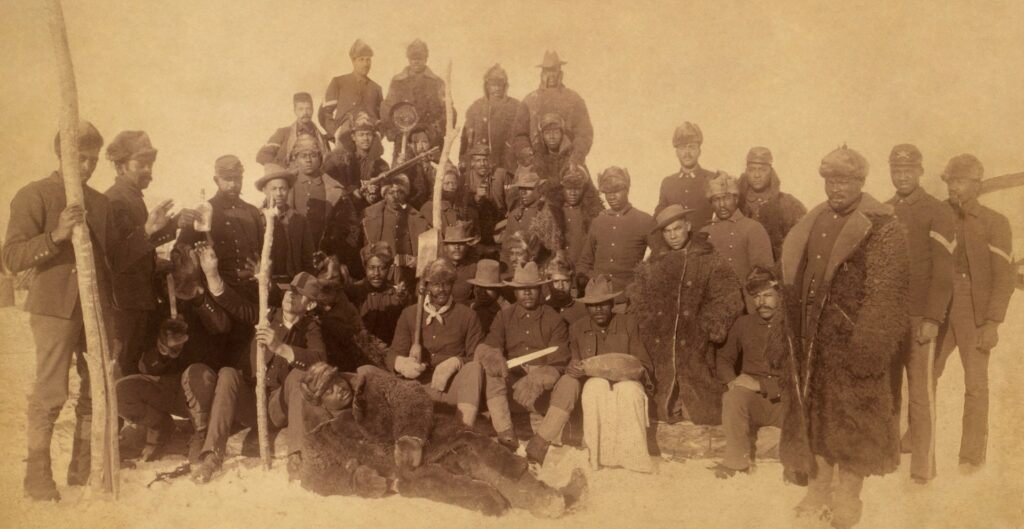
The fort is notable for being a base for Buffalo Soldiers, particularly the 10th Cavalry Regiment.
These African American regiments were critical in maintaining order and providing security on the frontier. Their duties included protecting stage routes, building infrastructure, and engaging in combat against hostile forces.
Indian Wars and the Defense of the Frontier
During the Indian Wars, Fort Concho was central to military operations against various Native American tribes.
Commanders like Ranald S. Mackenzie used Fort Concho as an expedition staging ground. The fort’s personnel were instrumental in campaigns designed to control and defend the expanding frontier against resistance from indigenous populations.
Fort Concho’s Military Life
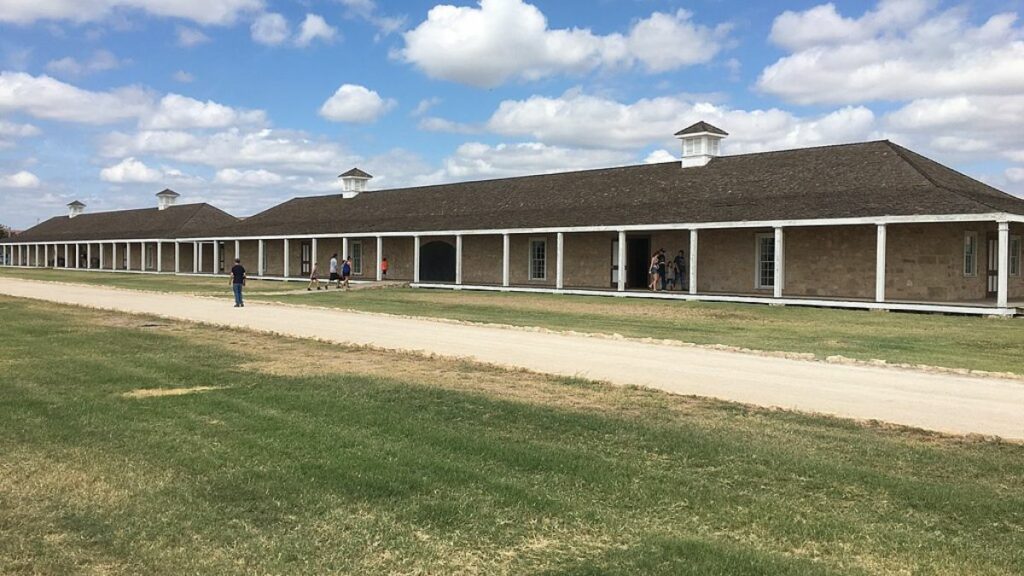
Fort Concho was a bustling center of military activity, hosting both cavalry and infantry regiments. It served as a critical hub for protecting settlers and maintaining regional order.
Cavalry and Infantry Regiments
The fort was home to various cavalry and infantry regiments.
The Fourth and Tenth United States Cavalry, also known as Buffalo Soldiers, played essential roles.
These units were tasked with patrolling the vast and often hostile territories.
They engaged in numerous skirmishes with Native American tribes and protected settlers from potential threats.
The cavalrymen were responsible for scouting, rerouting supplies, and maintaining communication lines.
Infantry regiments focused on securing the fort and building lasting relationships with local communities.
These soldiers usually performed frequent drills, honing their skills for rapid deployment if needed.
Everyday Life at the Post
Everyday life at Fort Concho blended routine duties and social activities.
Soldiers spent significant time drilling, maintaining equipment, and performing guard duties at the Guardhouse.
The Headquarters Building served as the administrative hub where orders were issued and strategies devised.
Soldiers engaged in communal activities such as sports, games, and social events in their free time.
The Stables were vital to daily operations, ensuring the cavalry regiments were always ready for rapid deployment.
Life at the fort often included chores like cooking and cleaning, essential for the smooth running of the post.
Notable Military Leaders
Several notable military leaders were linked to Fort Concho.
An accomplished cavalry leader, Benjamin Grierson was significant for his campaigns against hostile tribes. He played a crucial role in maintaining order and safeguarding the region.
Ranald Mackenzie, another key figure, led many successful operations against Native American tribes.
Known for his relentless pursuit and tactical brilliance, Mackenzie made a lasting impact on the area.
Their leadership not only protected settlers but also shaped the legacy of Fort Concho, highlighting its strategic importance.
Architecture & Structure of Fort Concho
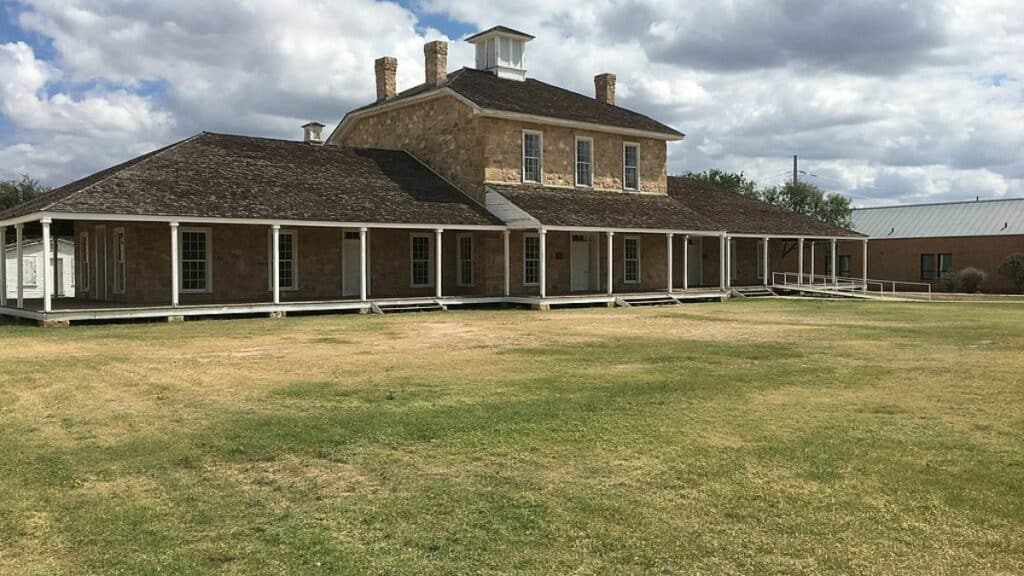
Fort Concho’s architecture exemplifies the use of native limestone and strategic military planning. Key structures such as the hospital, schoolhouse, and bakery were essential in the fort’s operations.
Limestone Buildings and Construction
Fort Concho is renowned for its limestone buildings, which are constructed from locally sourced materials.
Cultural Impact and the Community

Fort Concho has significantly shaped San Angelo, influencing its growth, development, and military history in West Texas.
San Angelo’s Growth and Development
The establishment of Fort Concho in 1867 was a key factor in the development of San Angelo.
The fort attracted settlers, merchants, and tradespeople, contributing to the settlement’s growth.
Businesses sprouted around the fort to cater to soldiers and their families. As a result, San Angelo quickly evolved from a small settlement to a bustling hub.
The fort’s presence ensured a steady economic activity as it became a center for trade and commerce.
Furthermore, infrastructure construction, such as roads and buildings, bolstered San Angelo’s expansion.
Many of the early structures remain as historical landmarks and reminders of the city’s origins.
Military Influence on West Texas
Fort Concho was crucial in protecting settlers and maintaining peace in West Texas.
The fort housed regiments tasked with safeguarding the region from raids and conflicts, fostering a sense of security among the settlers.
This military presence was pivotal in encouraging more people to move into the area.
The fort also served as a training ground for soldiers, many of whom became influential figures in later military campaigns.
Its strategic location and well-trained troops contributed to the overall safety and stability of the frontier settlements.
The legacy of Fort Concho’s military influence remains a significant aspect of West Texas history and culture.
Preservation and Education
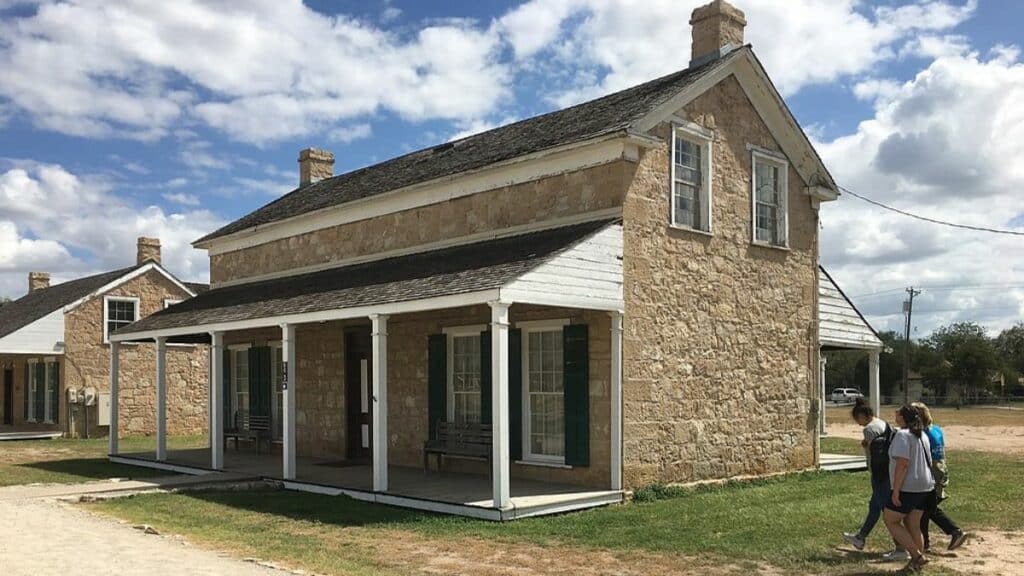
Fort Concho is committed to maintaining its historical significance while educating the public about its past.
Efforts focus on preservation activities and educational programs that engage visitors of all ages.
Historic Preservation Efforts
Fort Concho’s preservation efforts include maintaining over 20 historic structures.
These buildings, restored to their original 19th-century conditions, provide a genuine glimpse into frontier military life.
Conservation specialists are tasked with ongoing maintenance to prevent deterioration and ensure that the site’s historical integrity remains intact.
The site also hosts living history events, where reenactors demonstrate the daily life and activities of soldiers stationed at the fort.
These events provide a dynamic way to experience history firsthand.
Artillery drills, cavalry exercises, and other activities bring the past to life and help preserve traditional skills and knowledge.
Educational Programs and Outreach
The fort offers a range of educational programs aimed at children and adults.
School field trips are vital, providing students with an interactive learning experience through hands-on activities and guided tours.
The fort’s Museum Exhibits offer detailed displays on the history of the fort, Native American relations, and the settlement of the area.
Outreach programs extend the fort’s educational mission beyond its walls by traveling to schools and community groups.
Workshops, lectures, and the Research Library are also available for in-depth historical research and study.
This combination of onsite and offsite educational activities ensures a broad dissemination of knowledge about Fort Concho’s history and significance.
Collections and Exhibitions
Fort Concho’s museum offers diverse artifacts, archival materials, and permanent and traveling exhibits, painting a vivid picture of military history and frontier life.
Artifacts and Archives
The museum’s collections include thousands of artifacts from the late 19th century.
Weapons, uniforms, and personal items from soldiers stationed at Fort Concho provide a tangible connection to the past.
The Research Library houses extensive archival materials. Letters, photographs, and official documents are available for study.
These records give visitors an in-depth look at the daily lives of soldiers and officers.
Special items in the collection include original maps and blueprints of the fort. These rare documents offer insights into historical military strategies and engineering practices of the time.
Permanent and Traveling Exhibits
Permanent exhibits at Fort Concho showcase life in a frontier military post.
Visitors can explore reconstructed barracks, officers’ quarters, and a blacksmith shop. Each exhibit features painstakingly curated displays of period-accurate artifacts and images.
Traveling exhibits regularly rotate through the museum, providing fresh perspectives on broader historical themes.
These exhibits often come from other renowned institutions, offering unique opportunities for visitors to see rare items.
Interactive displays in the Exhibit Hall allow visitors to engage with history hands-on.
These exhibits combine educational content with engaging presentations, making history accessible to all ages.
Community Events and Tourism
Fort Concho offers a variety of community events and tourism opportunities. These include annual celebrations and guided tours that attract both locals and visitors.
Annual Celebrations and Gatherings
Fort Concho hosts several annual events that have become local traditions.
One of the most notable is Christmas at Old Fort Concho, a three-day festival featuring holiday crafts, food vendors, and live performances.
This event aims to recreate the festive atmosphere of the 19th century and includes interactive activities for the entire family.
Another popular event is Frontier Day, which celebrates the history and culture of the Old West.
This event features reenactments, historical exhibits, and educational activities.
Participants can enjoy guided tours, watch live demonstrations, and even try their hand at traditional crafts.
These gatherings preserve Fort Concho’s heritage and provide educational experiences that engage both young and old.
Visitor Engagement and Tours
Fort Concho offers structured tours that provide in-depth insights into its history and operations.
The Visitor Center is the starting point, offering detailed maps, brochures, and multimedia presentations.
Staff at the Visitor Center are knowledgeable and available to answer questions and provide additional context.
Tour options include guided tours of the Tour Building, which houses various exhibits and historical artifacts.
Visitors can explore barracks, officer quarters, and other structures, each offering a glimpse into soldiers’ daily lives at the fort.
Specialized tours can be arranged in advance, such as those focusing on specific historical events or figures.
These tours are led by experts who provide comprehensive narratives, making the history of Fort Concho accessible and engaging for all visitors.
Explore More: Army Forts in Texas
Support and Development
Fort Concho thrives through various support mechanisms, including significant non-profit contributions and strategic plans.
These efforts ensure its preservation, growth, and sustained relevance.
Non-Profit Contributions and Giving
Non-profits play a crucial role in Fort Concho’s development.
Organizations like the Fort Concho Foundation, local historical societies, and private donors have committed substantial resources.
Key Contributions:
- Financial Donations
- Volunteer Workforce
- Historical Artifact Preservation
The Fort Concho Foundation organizes yearly fundraising events, generating essential funds.
The City of San Angelo also allocates budgetary support, bolstering these efforts.
This synergy allows Fort Concho to maintain its structures, offer educational programs, and host community events.
Future Plans for Fort Concho
Significant plans are in motion to enhance Fort Concho’s facilities and programs. These plans include restoring additional historic buildings to expand educational and interactive exhibits.
Planned Developments:
- Constructing New Visitor Centers
- Expanding Interactive Displays
- Introducing Digital Tours
The City of San Angelo and partnering foundations prioritize these projects to attract more tourists and provide rich historical experiences.
Integrating modern technology aims to make visits more engaging for a diverse audience and ensure that the fort remains a vibrant educational hub.
Explore More: 10 Historic Forts in Texas: Exploring a Rich Military Heritage
Key Player in the Network of Frontier Forts
Fort Concho, now a State Historic Site and on the National Register of Historic Places, played a crucial role in the broader network of frontier forts.
The Broader Network of Frontier Forts
Fort Concho was part of a larger network of frontier forts established to protect settlers and maintain order in the American West.
Alongside Fort Chadbourne and Camp Charlotte, Fort Concho served as a key military post in Texas.
The fort helped secure vital routes such as the Butterfield Overland Mail, which is essential for communication and transportation.
Its strategic placement near the Middle Concho River provided resources and a tactical advantage.
The presence of Fort Concho in this network emphasized its significance in maintaining stability and facilitating expansion westward.
Comparison with Nearby Historic Sites
Comparing Fort Concho with nearby sites such as Fort Chadbourne and Camp Kelly reveals its unique contributions.
Fort Concho was more extensive and better preserved, providing a clearer glimpse into military life during that era. In contrast, Fort Chadbourne, although significant, has fewer standing structures today.
Camp Charlotte had a shorter operational period, historically making Fort Concho more pivotal.
Fort Concho’s comprehensive preservation offers visitors insight into soldiers’ daily lives and the broader scope of frontier defense mechanisms. It remains an essential destination for understanding the historical landscape of Texas forts.

Cory is a website owner and content creator who enjoys fishing, history, coin collecting, and sports, among other hobbies. He is a husband and father of four.
Romans 15:4 For whatever was written in former days was written for our instruction, that through endurance and through the encouragement of the Scriptures we might have hope.

